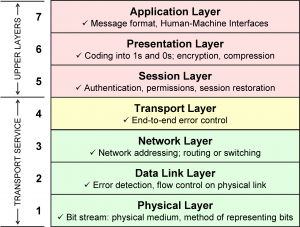Open System Interconnection Model is a well defined hierarchy architecture of seven communication layers. This article is about OSI model explanation.
Apart from reviewing startups, we’re now responding to some of the issues that our readers have been constantly asking for. Many of our readers have suggested us to write about basic networking concepts, but simplified and digestible.
From now on, you can expect a regular flow of such write-ups relating to Web and Networking concepts. Here goes the first one… 
OSI Model
Open System Interconnection (OSI) Model is a well defined hierarchy architecture of seven communication layers, each of which, represents several protocols, serving particular requirements for efficient and error-free data communication over single or multiple networks.
This multi-layered model developed by the International Organization for Standardization (ISO) forms the basis of data communication over the internet and smaller public or private networks.
Seven layers of OSI Model
The seven layers that stack together in the OSI model are : Physical, Data Link, Network, Transport, Session, Presentation and Application layer. Let’s analyze the layers further.
Physical layer : It is the lowest layer of OSI Model that defines the electrical and physical interface specifications of the endpoint devices. It tells you how a device is connected to another device across a network. The physical interface can be a serial, ethernet or any other physical medium of data transfer.
Data Link layer : This layer defines the logical procedures for error-free and time-bound data transfer from one network terminal to another. Protocols used under Data link layer such as Serial Line Internet Protocol (SLIP) or Address Resolution Protocol (ARP) try to rectify the errors that might have occurred as a result of data transmission across physical layer.
Network layer : It is probably the most critical layer in the entire OSI model. Network layer holds the responsibility of implementing appropriate protocols and procedures to route the data efficiently from source to destination client across single or multiple networks. It involves various routing and routed (Routing and Routed are different, explanation held for another dedicated write-up)
Transport layer : This layer is responsible for the reliability of the data to be transferred across the network. The protocols below this layer, namely Transmission Control Protocol (TCP), User Datagram Protocol (UDP) among others, ensure data reliability through flow control, segmentation & desegmentation and error control.
Session layer : As the name suggests, this layer controls and monitors the sessions held between computers, either locally or remotely, across the network. Protocols such as Session Announcement Protocol (SAP) and NetBIOS basically administer network connections (or sessions), right from establishment to termination.
Presentation layer : This layer has two major purposes, format translation and encryption. It is the responsibility of presentation layer to translate information from the network layer, making the data interpretable to Application layer and vice-versa. The other key responsibility is encryption, which basically adds an additional level of security before data transmission across the network takes place.
Application layer : This layer represents the software applications used by the end user. Application layer protocols such as HTTP, FTP, Telnet among others, facilitate the end user to do needful tasks using various software applications.

